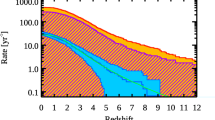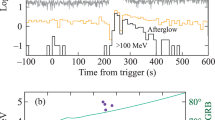Abstract
The prompt gamma-ray/X-ray emission of gamma-ray burst (GRB) 060218 was simultaneously observed by the Burst Alert Telescope (BAT) and X-ray Telescope (XRT) onboard Swift. Its peak energy of the joint vf v spectrum (E p) clearly evolves with time from tens of keV to ∼1 keV, crossing both the BAT and XRT bands. The best fit yields log E p=(4.61±0.23)+(−1.29±0.08) log t, with a correlation coefficient of 0.98 and a chance probability of p<10−4. We derive its bolometric flux (F) in the 0.01–104 keV band, and find that its F-E p relation, with a power-law index of 0.37, is much shallower than that observed in typical GRB pulses. Discussion of this shallowness is presented.
Similar content being viewed by others
References
Zhang B. Gamma-ray bursts in the Swift era. Chin J Astron Astrophys, 2007, 7: 1–50
Band D, Matteson J, Ford L, et al. BATSE observations of gamma-ray burst spectra. I — Spectral diversity. Astrophys J, 1993, 413: 281–292
Liang E, Kargatis V. Dependence of the spectral evolution of γ-ray bursts on their photon fluence. Nature, 1996, 381: 49–51
Amati L, Frontera F, Tavani M, et al. Intrinsic spectra and energetics of BeppoSAX Gamma-ray bursts with known redshifts. Astron Astrophys, 2002, 390: 81–89
Liang E W, Dai Z G, Wu X F. The Luminosity-E p relation within gamma-ray bursts and the implications for fireball models. Astrophys J, 2004, 606: L29–L32
Liang E W, Zhang B, Virgili F, et al. Low-luminosity gamma-ray bursts as a unique population: Luminosity function, local rate, and beaming factor. Astrophys J, 2007, 662: 1111–1118
Cobb B E, Bailyn C D, van Dokkum P G, et al. SN 2006aj and the nature of low-luminosity gamma-ray bursts. Astrophys J, 2006, 645: L113–L116
Amati L, Frontera F, Guidorzi C, et al. GRB060218: ep,i — eiso correlation. GCN 4846, 2006
Campana S, Mangano V, Blustin A J, et al. The association of GRB 060218 with a supernova and the evolution of the shock wave. Nature, 2006, 442: 1008–1010
Toma K, Ioka K, Sakamoto T, et al. Low-luminosity GRB 060218: A collapsar jet from a neutron star, leaving a magnetar as a Remnant? Astrophys J, 2007, 659: 1420–1430
Liang E W, Zhang B B, Stamatikos M, et al. Temporal profiles and spectral lags of XRF 060218. Astrophys J, 2006, 653: L81–L84
Kaneko Y, Preece R D, Briggs M S, et al. The complete spectral catalog of bright BATSE gamma-ray bursts. Astrophys J Suppl Ser, 2006, 166: 298–340
Band D L, Norris J P, Bonnell J T. Gamma-ray burst intensity distributions. Astrophys J, 2004, 613: 484–491
Sakamoto T, Barbier L, Barthelmy S D, et al. Confirmation of the Esrcpeak-Eiso (Amati) relation from the X-ray flash XRF 050416A observed by the Swift Burst Alert Telescope. Astrophys J, 2006, 636: L73–L76
Zhang B, Mészáros P. An analysis of gamma-ray burst spectral break models. Astrophys J, 2002, 581: 1236–1247
Dai Z G, Zhang B, Liang E W. GRB 060218/SN 2006aj: Prompt emission from inverse-compton scattering of shock breakout thermal photons. eprint arXiv:astro-ph/0604510
Wang X Y, Li Z, Waxman E, et al. Nonthermal gamma-ray/X-ray flashes from shock breakout in gamma-ray burst — Associated supernovae. Astrophys J, 2007, 664: 1026–1032
Author information
Authors and Affiliations
Corresponding author
Additional information
This work was supported by the National Basic Research Program of China (Grant No. 2009CB824800), the National Natural Science Foundation of China (Grant Nos. 10873002 and 10747001), Guangxi SHI-BAI-QIAN Project (Grant No. 2007201), the Program for 100 Young and Middle-aged Disciplinary Leaders in Guangxi Higher Education Institutions, and the Research Foundation of Guangxi University (Grant No. M30520).
Rights and permissions
About this article
Cite this article
Dong, W., Liang, E. & Lu, R. The flux-E p relation within GRB060218 in comparison with typical GRB pulses. Sci. China Phys. Mech. Astron. 53 (Suppl 1), 78–81 (2010). https://doi.org/10.1007/s11433-010-0029-x
Received:
Accepted:
Published:
Issue Date:
DOI: https://doi.org/10.1007/s11433-010-0029-x




